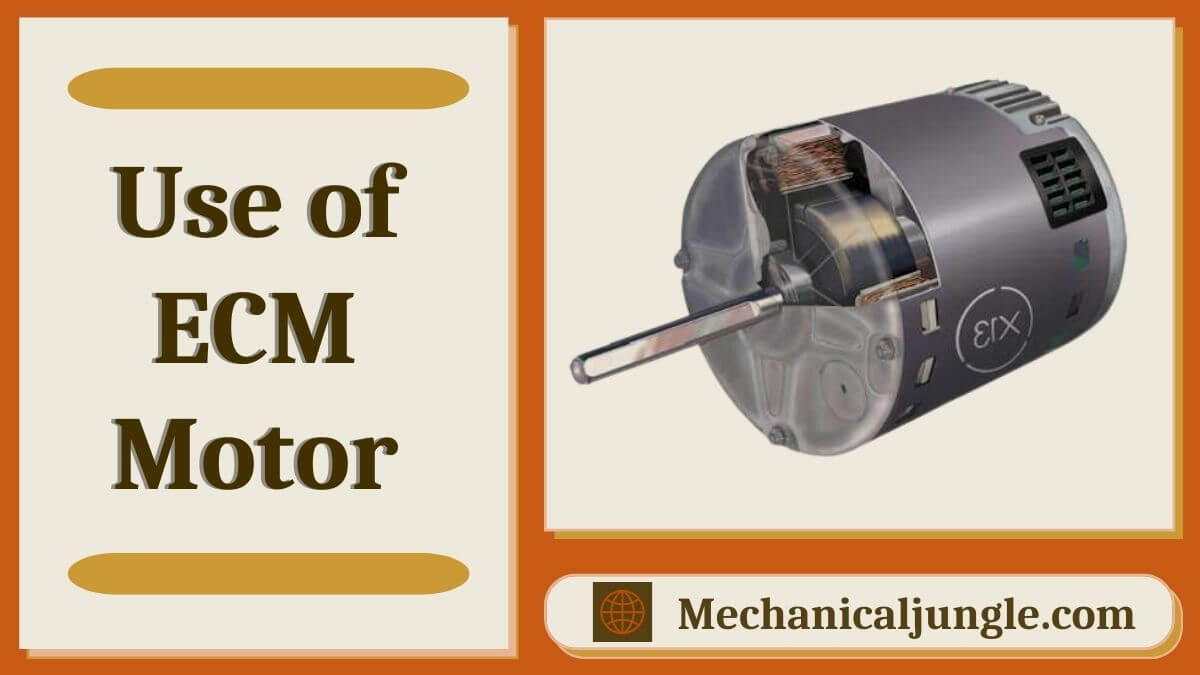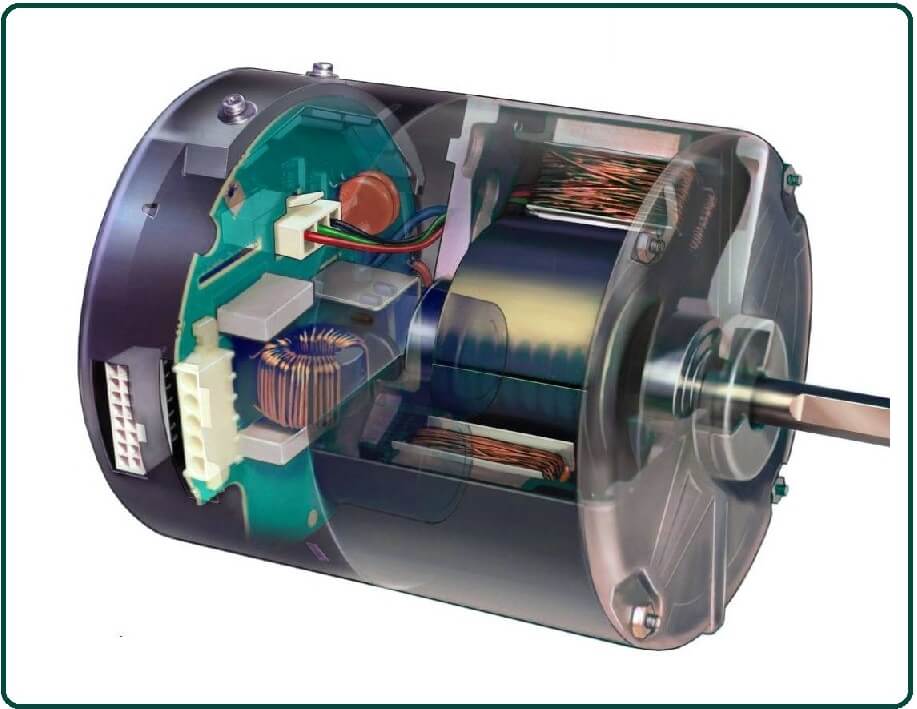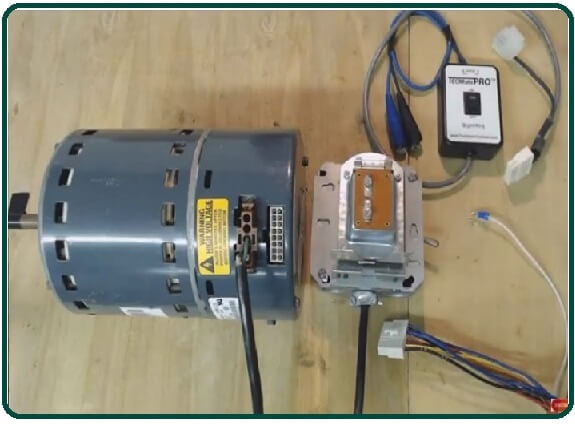
What Is an ECM Motor?

ECM stands for “Electronically Commutated Motors,” which basically means a motor that uses electronic control to change its speeds. There are three types of ECM motor: constant CFM, constants RPM, & constants torque.
Since CFM, RPM and torques are all related, the basic principles are the same. But for the sake of eases of discussions, I am going to focus on the Constant Torque ECM Motor.
HVAC (Heating, Ventilation, and Air Conditioning) device is those that heat or cool a certain area. They are especially important when building large office buildings or climate-controlled settings. One of the primary objectives of current HVAC research is to identify ways to improve machine energy quality.
Energy savings are not only a great way for homeowners & business owners to save money, but they are also good for the world. An ECM engine, also known as a variable-speed motor, is an important advancement for air conditioners and furnaces.
In layman’s terms, an ECM motor reduces the overall power consumption of an AC or furnace while assisting in the maintenance of adequate airflow through the device.
Constant Torques ECM is made up of two parts, the motors, and the ECM microprocessor, both of which are housed in a shell. The microprocessor is the “brain” of the motor. It holds the logic that controls the motors.
Logics are math equation or algorithm that finds the ideal airflow for each specific piece of HVAC equipment and uses a formula to calculate the exact relationship between motor speed and torque to maintain that airflow.
It should be noted that ECM motors programming is specifics to each model of HVAC type of equipment, so programming is only done at the factories, not in the fields.
When ordering a replacement ECM motor, the tech must know the specifications of the model in which the motor will be installed to function properly.
The most important feature of an ECM motor is its low energy consumption. The biggest drawback of this motor is its complexity.
These motors are more prone to failure due to the electronics used in these motors. Let’s continue reading how ECM motors work, where it is used, and summarize the pros and cons.
Use of ECM Motor:

The use of ECM motors is increasing rapidly. Today, all motors used in residential & light commercial HVAC (indoor and outdoor) and commercial refrigeration evaporators and condensers have ECM application.
It provides improved electrical efficiency as well as the ability to program more precise and regulated motor operation on a wider variety of HVAC system outputs, thereby improving user comfort.
How Does an ECM Motor Work?
Once the settings are programmed into the microprocessor at the factory and the control board dip switches are set to field, motor torque and airflow (CFM) should remain constant.
What will change the motor speed (RPM)? Depending on system conditions, motors will need to spin faster or slower to maintain steady torque and airflow.
This was where the people in my office and I got really stuck. We couldn’t figure out what could have triggered the change in torque? This draws out its static pressure in the systems.
When the loads or demand on the systems increases (as if it is really hot outside, for example), high static pressure exists.
Higher cooling demand increases condensation on the evaporator’s coils, reducing airflow (hence the higher static pressure). Resistance to airflow can also be caused by a clogged filter or dirty coils, which will also increase the static pressure.
This high pressure increases the torque on the motor. An increased torque basically means that more “muscle” is needed to turn the motor. The higher pressure essentials create additional resistance on the blades of the fan motor, which is why it needs more “muscle” or torques to turn the motor.
When the microprocessor increases the sensitive torque, it automatically increases the speed of the motor. A faster motor creates more airflow to ensure that the CFM system remains stable despite resistance from conditions such as a clogged filter or hard-working evaporator.
More airflow also lowers the static pressure, which reduces torque. At the same time, the increased airflow also provides the additional oomph of airflow that is needed to provide additional cooling or heating capacity to the system during times of high demand for the system.
Advantages of ECM Motor:
- An ECM motor consumes fewer wattages than normal motors.
- The multi-speed of the ECM motor allows it to reduce the drying effect that can occur during winter heating while still reducing cold and hot spots in the home.
- The ECM motor can be programmed with multiple inputs to vary the speed and voltage using the internal smart screen.
- ECM-equipped systems, when properly configured, can enhance dehumidification, reduce register noise, conserve power & provide trouble-free services.
- Furnaces or air handlers with an ECM may operate flawlessly when mounted on a good vent, coil, and filtration device with constant pressure under proper design parameters.
This is because the motor can deliver precise airflow to balance the two-speed condenser design and multi-stage gas furnace firing speed to provide silent, draft-free comfort in almost any configuration. - An ECM may use only less energy to start a motor, but its microprocessor controllers can be designed to further reduce current pull during off-peak hours and maximize energy consumption while running. This results in ECM efficiency exceeding 90%.
Is ECM Motor Disadvantageous?
- The structure of an ECM motor is structurally complex as its stator has multiple windings & involves precise timing from some controls module to rotate rotors. On the other hand, although this is complexity allows for greater performances, less noise, and better-operating characteristics, maintenance on EC motors takes longer & is more expensive.
- ECM-generated high velocities & pressures on systems with dirty evaporator coils can also blast moisture off the coil surfaces in the supply ductwork. This will reduce the ability of the system to overheat and trigger a variety of humidity-related indoor air quality problems.
- When operating continuously in an over-amped environment, some older ECM motors will overheat and even malfunction.
- Noise on the registers from high air velocities is another effect of high static installations. Filter media can be pulled out of the rack under severe conditions, resulting in filter bypass. Under severe conditions, the filter media will be drawn into the fan, cut off, and blown around the device, causing extensive damage.
FAQ on ECM Motors
What is an ECM motor?
An ECM (Electronically Commutated Motor) is a type of motor that uses electronic control to change its speeds. It is designed to improve energy efficiency and performance in HVAC systems.
What are the different types of ECM motors?
There are three types of ECM motors:
- Constant CFM (Cubic Feet per Minute)
- Constant RPM (Revolutions Per Minute)
- Constant Torque
Why focus on Constant Torque ECM motors?
Constant Torque ECM motors are commonly used in HVAC systems because they maintain steady torque and airflow, adjusting motor speed as needed based on system conditions.
How do ECM motors benefit HVAC systems?
ECM motors reduce overall power consumption, maintain adequate airflow, improve electrical efficiency, and offer precise, regulated motor operation, enhancing user comfort and system performance.
How does a Constant Torque ECM motor work?
A Constant Torque ECM motor maintains steady torque and airflow by adjusting its speed based on system conditions. The motor’s microprocessor, programmed at the factory, controls the motor speed to ensure consistent performance despite changes in static pressure.
What triggers changes in motor speed for an ECM motor?
Changes in motor speed are triggered by variations in system conditions, such as high static pressure due to increased cooling demand, a clogged filter, or dirty coils. These conditions increase torque, causing the motor to speed up to maintain airflow.
What are the advantages of using an ECM motor?
- Lower energy consumption
- Multi-speed operation reducing drying effects during heating and eliminating hot and cold spots
- Programmable for precise speed and voltage control
- Enhanced dehumidification and reduced register noise
- High efficiency, exceeding 90% in some cases
What are the disadvantages of ECM motors?
- Structural complexity, making maintenance more expensive and time-consuming
- Potential issues with high velocity and pressure in systems with dirty coils, causing moisture problems
- Risk of overheating and malfunction in over-amped environments
- Noise from high air velocities and potential filter media issues under severe conditions
Where are ECM motors commonly used?
ECM motors are increasingly used in residential and light commercial HVAC systems, including indoor and outdoor units, as well as commercial refrigeration evaporators and condensers.
How should one approach ordering a replacement ECM motor?
When ordering a replacement ECM motor, it is crucial to know the specifications of the HVAC model in which the motor will be installed to ensure proper functionality and performance. Programming for ECM motors is specific to each model and done at the factory.

